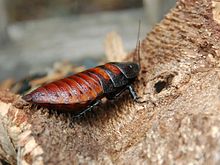This article has multiple issues. Please help improve it or discuss these issues on the talk page. (Learn how and when to remove these messages)
|
| Madagascar hissing cockroach | |
|---|---|

| |
| Female | |
| Scientific classification | |
| Domain: | Eukaryota |
| Kingdom: | Animalia |
| Phylum: | Arthropoda |
| Class: | Insecta |
| Order: | Blattodea |
| Family: | Blaberidae |
| Genus: | Gromphadorhina |
| Species: | G. portentosa
|
| Binomial name | |
| Gromphadorhina portentosa (Schaum, 1853)
| |

The Madagascar hissing cockroach (Gromphadorhina portentosa), also known as the hissing cockroach or simply hisser, is one of the largest species of cockroach, reaching 5 to 7.5 centimetres (2 to 3 inches) at maturity. They are native to the island of Madagascar, which is off the African mainland, where they are commonly found in rotting logs. It is one of some 20 known species of large hissing roaches from Madagascar, many of which are kept as pets, and often confused with one another by pet dealers; in particular, G. portentosa is commonly confused with G. oblongonota[1][better source needed] and G. picea.[2]
Unlike most cockroaches, they are wingless; The “hissing” sound (expelling air through their bodies) is their primary defense, to frighten potential predators, as they cannot fly and are easily captured. They can reproduce asexually, but usually reproduce sexually. They are excellent climbers and can scale smooth glass. Males can be distinguished from females by their thicker, hairier antennae and the very pronounced bumps on the pronotum. Females carry the ootheca internally, and release the young nymphs only after her offspring have emerged within her (this is known as ovoviviparity). As in some other wood-inhabiting roaches, the parents and offspring will commonly remain in close physical contact for extended periods of time. In captivity, they have been known to live up to 5 years. They feed primarily on vegetable material.
- ^ "Gromphadorhina oblongonota or G. Portentosa?". Allpet Roaches Forum. 22 September 2011. Archived from the original on 18 March 2016. Retrieved 10 March 2013.
- ^ Delfosse, E. (2004) Les blattes souffleuses de Madagascar. Insectes 153: 19–22.